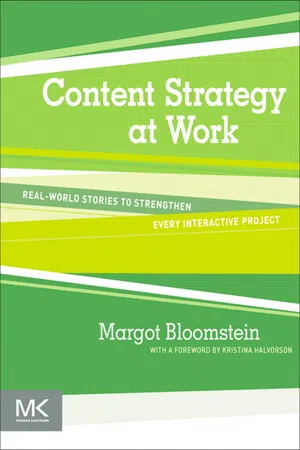
Content Strategy at Work
Real-world Stories to Strengthen Every Interactive Project
- 184 pages
- English
- ePUB (mobile friendly)
- Available on iOS & Android
Content Strategy at Work
Real-world Stories to Strengthen Every Interactive Project
About this book
Content is king… and the new kingmaker… and your message needs to align with your model and metrics and other mumbo jumbo, right? Whether you're slogging through theory or buzzwords, there's no denying content strategy is coming of age. But what's in it for you? And if you're not a content strategist, why should you care?Because even if content strategy isn't your job, content's probably your problem—and probably more than you think. You or your business has a message you want to deliver, right? You can deliver that message through various channels and content types, from Tweets to testimonials and photo galleries galore, and your audience has just as many ways of engaging with it. So many ways, so much content… so where's the problem? That is the problem. And you can measure it in time, creativity, money, lost opportunity, and the sobs you hear equally from creative directors, project managers, and search engine marketing specialists.The solution is content strategy, and this book offers real-world examples and approaches you can adopt, no matter your role on the team. Put content strategy to work for you by gathering this book into your little hands and gobbling up never-before seen case studies from teams at Johns Hopkins Medicine, MINI, Icebreaker, and more. Content Strategy at Work is a book for designers, information architects, copywriters, project managers, and anyone who works with visual or verbal content. It discusses how you can communicate and forge a plan that will enable you, your company, or your client get that message across and foster better user experiences.- Presents a content strategy framework and ways to implement in both in-house marketing departments and consultancies- Includes case studies, interviews, and lessons learned from retail, apparel, network television, business-to-business, automotive, non-profit, and higher ed brands- Details practical sales techniques to sell content strategy and use content strategy processes to sell other services and larger projects
Frequently asked questions
- Essential is ideal for learners and professionals who enjoy exploring a wide range of subjects. Access the Essential Library with 800,000+ trusted titles and best-sellers across business, personal growth, and the humanities. Includes unlimited reading time and Standard Read Aloud voice.
- Complete: Perfect for advanced learners and researchers needing full, unrestricted access. Unlock 1.4M+ books across hundreds of subjects, including academic and specialized titles. The Complete Plan also includes advanced features like Premium Read Aloud and Research Assistant.
Please note we cannot support devices running on iOS 13 and Android 7 or earlier. Learn more about using the app.
Information
Chapter 1
How content strategy can help
Opportunity versus priority







All the tea in China, all the content types on the web
Tough choices require something stronger than just tea
Table of contents
- Cover Image
- Contents
- Title
- Copyright
- Praise Page
- Foreword
- Thank you
- About the Author
- Chapter 1. How content strategy can help
- Chapter 2. Designing cohesive experiences: Introducing content strategy to design
- Chapter 3. Embracing reality: Incorporating content strategy into project management and information architecture
- Chapter 4. Executing on content strategy through copywriting, creation, and curation
- Chapter 5. Coupling content strategy with search engine optimization
- Chapter 6. Improving content management with content strategy
- Chapter 7. Grounding social media in content strategy
- Chapter 8. Growing the business and getting to work
- Index